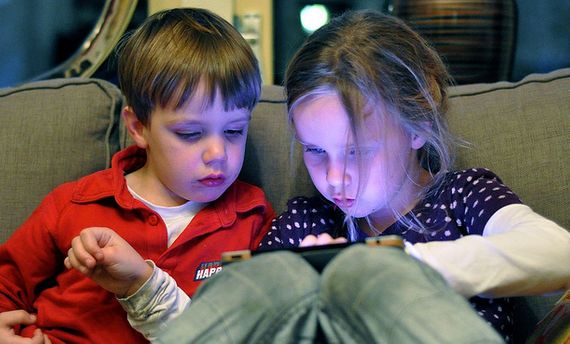In the 1980s it began to be discussed whether it was appropriate to limit the access of children to television, in the wake of certain studies that seemed to relate excessive time in front of the screen with a higher incidence of obesity and difficulties in reading. It was a new problem that fathers and mothers had to face. Three decades later, new variables have been introduced in the problem: computers, Internet, smartphones, social networks and online videogames… Today more than ever, having children forces us to confront a thorny question: Should I limit the amount of time they spend in front of screens?
The Internet itself, on which many youngsters and teenagers spend long hours via their tablets or smartphones, is where parents often turn to find answers to the problem. Obviously they are the ones who provide the first mobile phone to their children at an average age of 10.3 years—one in four receives it before the age of six—but then they need to know if their decision could harm the emotional or intellectual development of their children.
And yes, on the Internet they find answers. The website of the American Academy of Pediatrics (AAP) establishes certain rules: up to two years of age, only the occasional use of screens in the company of parents; from two to five years, a maximum of one hour a day. For older children and adolescents, the AAP does not set specific limits, although it recommends that they exist. Jenny Radesky, paediatrician of behavioural development at the University of Michigan (USA) and lead author of the guidelines of the AAP, tells OpenMind that: “most of the guidelines that have been issued about digital media use are actually quite similar.”
Two hours a day in school age
But taking a more emphatic stance, other experts argue for a maximum of two hours a day until the end of school age, as advised by the guidelines of the Canadian 24-Hour Movement—an initiative of the Canadian Society for Exercise Physiology. This limit is supported by the preliminary results of the Adolescent Brain Cognitive Development (ABCD), the largest long-term study undertaken in the US on brain development and its impact on children’s health.

Brain scans and tests performed on more than 4,000 children show that a screen time limit of two hours a day is related to better attention, memory and linguistic ability, especially if enough sleep is obtained. “These findings highlight the importance of limiting recreational screen time,” the study authors wrote.
More disturbing data appear as the hours of use of the devices increase: changes in brain structure are observed after seven hours a day. According to the co-author of this study Florence Breslin, from the Laureate Institute for Brain Research, these changes consist of a “decrease in cortical thickness and grey matter volume, which could indicate a slightly more mature brain.”
Other recent studies point in the same direction. The analysis of a population sample of more than 40,000 children and adolescents in the USA concluded that more than one hour of screen time a day correlates with a deterioration of emotional well being, especially in adolescents, where a higher incidence of depression or anxiety is observed. More screen time has been linked to mental health damage and an increase in suicide rates in adolescents, while different investigations have associated the excessive use of devices with loneliness, depression, obesity and worse sleep quality.
As if that were not enough, consider the claims of some Silicon Valley parents who say they have restricted their children’s access to technology because they know the effort that their companies invest in creating addictive products, according to Business Insider. There are already cases of adolescents in rehabilitation for an alleged addiction to the popular online game Fortnite.

“The problem here is the design of the digital environment, which was done with adult minds and market values in mind—without an understanding of how children might interact with it,” says Radesky. The paediatrician talks about “dark patterns” in the design of games, “whose ethics are questioned by developers yet whose use is quite commonplace in trying to influence user behaviour to make purchases or provide data.”
Controversial recommendations in the United Kingdom
With all the above, it might seem that the two-hour rule is a closed question; nevertheless, many experts are not convinced: in January 2019, the Royal College of Paediatrics and Child Health of the United Kingdom (RCPCH) caused an earthquake with the publication of its recommendations. “The evidence base for a direct toxic effect of screen time is contested, and the evidence of harm is often overstated,” the British paediatricians wrote, concluding: “We are unable to recommend a cut-off for children’s screen time overall.”
The main argument is summarised in the words of Max Davie, in charge of health promotion of the RCPCH: “Too much screen time may be associated with a range of health issues; however, there seems little evidence that this is causal.” Breslin confirms the same idea: “Right now we do not know if screen time causes these changes or if kids with these differences spend more time on screens, but we will follow this cohort to try to find that out.” In fact, she adds that not all the differences observed are negative: the intense use of video games “has a slightly positive correlation with fluid intelligence.”

For the RCPCH, the secret of these correlations might not be the use of the devices, but “lost opportunities for positive activities (socialising, exercise, sleep) that are displaced by screen time.” Therefore, its basic recommendation is “that families should negotiate screen time limits with their children based upon the needs of an individual child”, so that it does not interfere with other activities and avoiding the time before sleep.
How instead of how much
This position has received criticism from supporters of the two-hour limit, such as some of the researchers who have contributed to the development of the Canadian guidelines. “At least until new, robust evidence demonstrates no harm,” they say, “the most prudent approach would be cautious, attempting to follow recent evidence-based guidance that recreational screen time should be restricted.”
After all this, the parent who looks for answers on the Internet does not know whose advice to follow. But Radesky has the solution: “The most important take-away from this situation is not to have a tit-for-tat argument about who writes better guidelines, but recognise the consensus areas.” And for the paediatrician, this territory of agreement is beyond the debate about screen time: it is not about how much, but about what, why and how.

“Duration is much less relevant than how media are used, what times of day, what interpersonal contexts, and how the user’s psychology interacts with the persuasive design,” she says. Instead of obsessing over time, Radesky recommends that families “talk about content, misinformation, digital citizenship, and social interactions over media.”
So perhaps, deep down, the answer parents are looking for is not so much online as offline, in good family communication.
Comments on this publication